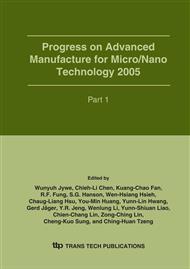p.421
p.427
p.433
p.439
p.445
p.451
p.457
p.463
p.469
Three-Body Microcontact Model of Rough Surfaces and Its Application on Polishing of Wafer
Abstract:
In this study, a three-body microcontact model for rough surfaces is proposed in order to understand the effects of particles between surfaces on contact characteristics and its application on polishing of wafer. Both transitional surface-to-surface and particle-to-surface two-body microcontact simulations can be obtained according to the simplification of this model. In the three-body contact situation, the curves of contact area ratio versus dimensionless load are located in the range between two straight lines. The surface-to-surface two-body contact situation is the upper bound and the particle-to-surface two-body contact situation is the lower bound. As the value of D/σ increases, the contact situation will approach the pure particle-to- surface 2-body contact situation. The model also is used to study the wear mechanisms of the silicon wafer.
Info:
Periodical:
Pages:
445-450
Citation:
Online since:
January 2006
Authors:
Keywords:
Price:
Сopyright:
© 2006 Trans Tech Publications Ltd. All Rights Reserved
Share:
Citation:


